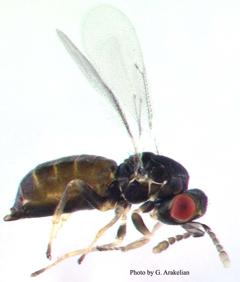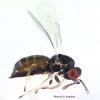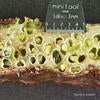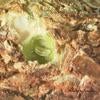Blue Gum Galling Wasp, Selitrichodes globulus
The Situation: Since 1850, eucalyptus trees of >90 species have been imported as seed from Australia into California for a wide range of ornamental and other uses. Eucalyptus are now an ubiquitous plant in urban areas in southern California, and these plants are becoming increasingly more common in California's natural areas too where some species are considered to be invasive weeds. In urban areas, these native Australian trees are valued for their fast growth and tolerance of poor soils and drought. Consequently, eucalyptus is considered by many a valuable landscape, shade, and windbreak tree. For more than a century, these species remained virtually pest free. However, beginning in the 1980s, a series of eucalyptus-feeding insects invaded the region, beginning with the borer Phoracantha semipunctata (Coleoptera: Cerambycidae), which was first detected in California in 1984. Since then about 15 other species of eucalypt herbivores have invaded California, includin
g another Phoracantha species(in 1995), the leaf feeding weevil Australian Gum Tree Weevil (in 1994), the chrysomelid leaf beetle Trachymela sloanei (in 1998), and at least six species of psyllids, including the blue gum psyllid (Ctenarytaina eucalypti) and two lerp physllids (Glycaspsis brimblecombei and Eucalyptolyma maideni).
Blue Gum Galling Wasp is thought to be native to Australia, although it has not been found in this country. Other species of gall forming eulophids native to Australia have successfully invaded other areas of the world in addition to California. For example, Ophelimus maskelli occurs naturally on Eucalyptus in New South Wales, Australia and is an invasive species in the Mediterranean region. Heavy galling of leaves by O. maskelli results in premature shedding of the leaves. The impact of high wasp populations on the canopy of Eucalyptus in Israel is very serious, and heavily damaged trees exhibit desiccation throughout large parts of their crowns. The adult galling wasps cause health problems to people during mass emergence from galls. Industrial areas surrounded by ornamental eucalyptus trees produce clouds of wasps during peak emergence periods and can be a human nuisance. A biological control program against O. maskelli in Israel has been conducted using a parasitic wasp, Closterocerus chamaeleon, and it appears to be providing good levels of control. It is possible that in Australia natural enemies of S. globulus exist and these could be used in a biological control program against this pest in California.
Damage: In November 2008, in Monrovia Los Angeles County, California, a homeowner discovered unusual gall like growths on branches of a backyard blue gum (Eucalyptus globulus complex). Additional infestations were found in Arcadia in Los Angeles County. This pest appears to be quite host specific, having only been recorded from blue gum eucalyptus. Ironically, this host specificity may lend itself to possible biological control of invasive blue gums, particularly in sensitive wilderness areas where these plants are not wanted.
Examination of these galls by County Entomologists revealed the presence of small internally feeding larvae which were responsible for the observed damage. Larvae were being reared to adulthood to confirm the association of adult galling wasps with observed galls. The life cycle of this pest may take up to five months to complete. Initial identifications tentatively placed with this wasp in the genus Ophelimus,but this identification was changed by specialists who work on this group of insects who recognized it as a species new to science. It is likely that in the absence of host specific natural enemies Blue Gum Galling Wasp will spread quickly throughout California and may cause considerable damage to vulnerable eucalyptus species. It is possible that this pest may invade other countries, such as Bolivia, China, Colombia, Ethiopia, India, Peru and Spain which grow blue gums commercially for fuelwood, pulpwood, and eucalyptus oil.
More Media on the Blue Gum Galling Wasp
The Guardian: New to Nature No. 20: Selitrichodes globulus
Blue Gum Galling Wasp local galleria
Center for Invasive Species Research, University of California Riverside
Text provided by Mark Hoddle, Department of Entomology, University of California, Riverside.
Photos by Gevork Arakelian, Senior Biologist, LA County Department of Agricultural Commissioner/Weights and Measures
Mark Hoddle, Extension Specialist and Director of Center for Invasive Species Research
mark.hoddle@ucr.edu
Personal Website
Media within CISR is licensed under a Creative Commons Attribution-NonCommercial-NoDerivs 3.0 Unported License. Permissions beyond this scope may be available at www.cisr.ucr.edu/media-usage.






